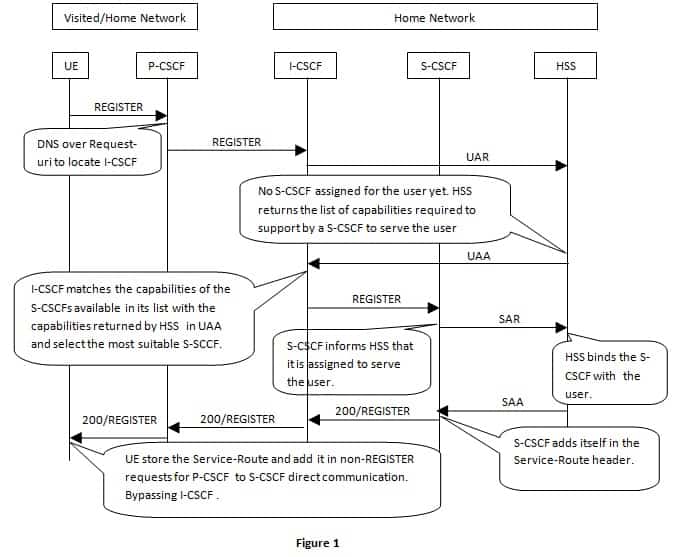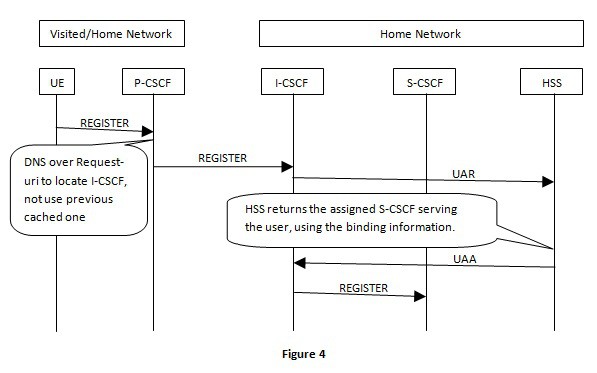How an IMS network assigns and maintains an S-CSCF for a user
When a user tries to register with an IMS network, it sends a REGISTER request to its P-CSCF. Since the REGISTER does not contain any Service-Route header (indicating the S-CSCF), the P-CSCF doesn’t know which S-CSCF to forward the message to (which S-CSCF is assigned to the UE). Hence it forwards the REGISTER to the I-CSCF. If the I-CSCF is not pre-configured, it is discovered by performing the DNS query for the home domain name (identified from request-URI). Figure 1 shows the message exchange.

Once the I-CSCF receives this REGISTER request it queries the HSS (if there are multiple HSSs, then the I-CSCF contacts the SLF to choose the desired HSS) using a User-Authorization-Request (UAR) Diameter request.
There are two possibilities at the HSS –
-
-
- It can either specify certain pre-assigned S-CSCF by mentioning it in the Server-Name field of the User-Authorization-Answer (UAA) diameter response, or
-
It can specify certain capabilities of potential S-CSCF in the Server-Capabilities field of UAA from which the I-CSCF can choose an S-CSCF for the user.
In the latter case, I-CSCF maintains a list of S-CSCFs available in the network along with their capabilities (in some operator-specific way, not specified by 3GPP).
Capabilities are certain features that the S-CSCF supports, for example, support for “SIP Digest Authentication”, “Loose-Route “, “Early IMS Security” etc. (refer to 3GPP 23.228 Table 6.7 for the list of capabilities).
HSS exposes the mandatory and optional capabilities (to be supported by the potential S-CSCFs) to the I-CSCF through the UAA message.
The operator assigns an integer to each capability known by the HSS and I-CSCF. Since the mapping of capabilities to integer values is used within the home network alone, this mapping is created in an operator-specific manner. In UAA the mandatory and optional capabilities are conveyed as their corresponding integer values.
Once the I-CSCF receives the required capabilities of the potential S-CSCFs, it identifies those S-CSCFs that support all the mandatory and optional capabilities from its list. If none is selected, the I-CSCF applies a best-fit algorithm on the list, to select a S-CSCF which supports all the mandatory capabilities and some of the optional capabilities.
For example, if the HSS specifies “SIP Digest Authentication” as mandatory and “Early IMS Security ” as optional selection criteria for the S-CSCF of the user, the I-CSCF will search for the S-CSCF which supports both of these features. If none is found, the S-CSCF which supports at least the “SIP Digest Authentication” feature will be chosen.
Once the I-CSCF selects the S-CSCF to serve the user, it forwards the REGISTER to the S-CSCF for further processing.
After the S-CSCF successfully authenticates the user, it informs the HSS through Server-Assignment-Request (SAR) and Server-Assignment-Answer (SAA) Diameter messages which user it is serving. Subsequently, the HSS creates a mapping between the user and the S-CSCF. This mapping ensures that the same S-CSCF will be contacted for any incoming call to the user.
In such a case, upon receiving the INVITE, the I-CSCF queries the HSS to discover the assigned S-CSCF for the user through a Location-Info-Request (LIR) Diameter request. The HSS then returns the assigned S-CSCF using the mapping in the answer through Location-Info-Answer (LIA). See Figure 2.

Moreover, the S-CSCF specifies itself in the Service Route of 200 OK of registration. When the user sends any non-REGISTER request (say INVITE), using this Service-Route information contained in the request, the P-CSCF directly forwards it to the S-CSCF (without interacting with the I-CSCF). See Figure 3.

Subsequent REGISTER requests (those at registration and de-registration) notably do not contain the Service-Route information. P-CSCFs forward the message to I-CSCF. The I-CSCF gets the assigned S-CSCF from HSS through the UAR and UAA and proceeds with the flow. See Figure 4 below

References
-
- 3GPP 23.228 Release 12
-
- 3GPP 24.229 Release 12
- 3GPP 29.228 Release 12
Author Name: Soumalya Kumar De





